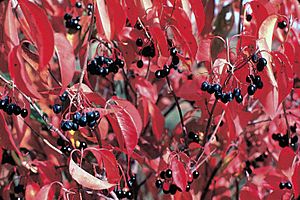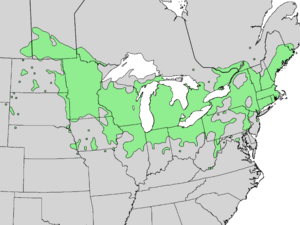Nannyberry facts for kids
Quick facts for kids Nannyberry |
|
|---|---|
 |
|
 |
|
| Scientific classification | |
| Genus: |
Viburnum
|
| Species: |
lentago
|
 |
|
| Natural range of Viburnum lentago | |
The Nannyberry (also known as sheepberry or sweet viburnum) is a type of large shrub or small tree. Its scientific name is Viburnum lentago. This plant grows naturally in North America.
Contents
What the Nannyberry Looks Like
The nannyberry can grow as a large shrub or a small tree. It can reach up to 9 meters (30 feet) tall. Its trunk can be about 25 centimeters (10 inches) wide. The tree has a rounded top and branches that hang down.
Its bark is usually reddish-brown or grayish-brown. It often breaks into small scales. The young twigs are light green and feel a bit fuzzy. As they get older, they turn dark reddish-brown. If you crush a twig, it might have a strong smell.
In winter, the plant has light red buds. These buds are covered with a pale, scaly fuzz. The buds that will become flowers are about 2 centimeters (3/4 inch) long. Other buds are smaller. As the plant grows, the bud scales get bigger and can look like tiny leaves.
Nannyberry Leaves
Like all viburnum plants, the leaves grow in pairs on the twigs. They are oval-shaped, about 5 to 10 centimeters (2 to 4 inches) long. They are also about 2 to 5 centimeters (3/4 to 2 inches) wide. The leaves are pointed at the tip and have tiny saw-like edges.
When they first appear, the leaves are shiny and bronze-green. They might have some fine hairs. When fully grown, they are bright green and shiny on top. The underside is paler and has small black dots. In the fall, the leaves turn a beautiful deep red, or a mix of red and orange.
Nannyberry Flowers and Fruit
The flowers of the nannyberry are small, about 5 to 6 millimeters (0.2 inches) across. They have five whitish petals. These flowers grow in large, round clusters called cymes. These clusters can be 5 to 12 centimeters (2 to 4.7 inches) wide. The nannyberry blooms in late spring.
After the flowers, the plant produces small, round, blue-black fruits. These fruits are called drupes and are about 8 to 16 millimeters (0.3 to 0.6 inches) long. They grow on reddish stems. The fruit has a thick skin and is sweet and juicy inside. The seed inside is flat and oval-shaped.
The roots of the nannyberry are thin and spread out. The wood is dark orange-brown and quite heavy.
Where Nannyberry Grows
The nannyberry is found naturally in the northeastern and midwestern United States. It also grows in southern Canada. You can find it from New Brunswick in the east to southeastern Saskatchewan in the west. Some smaller groups of nannyberry plants are also found in places like the Dakotas, Wyoming, Colorado, and the Appalachian Mountains. They grow as far south as Kentucky and Virginia.
This plant likes wet soil. You often see it along the edges of forests. It can also be found in fence corners and next to roads.
Nannyberry in Nature
The fruit of the nannyberry is an important food source for many animals. Mammals, like deer, eat the fruit. Game birds and songbirds also enjoy the fruit, especially during the winter months.
How People Use Nannyberry
The fruit of the nannyberry is edible, which means you can eat it! It's quite sweet, which is why it's sometimes called "sweet viburnum."
Native Americans also used the bark and leaves of the nannyberry. They used these parts to make herbal medicines.
People like to plant nannyberry trees in parks and gardens. They are admired for their neat shape and shiny leaves. Insects usually don't bother the leaves much. The plant also has pretty flowers, tasty fruit, and bright fall colors. It's a good choice for decorating outdoor spaces, especially in places with cold winters.
It's easy to grow nannyberry from seeds. However, the seeds take a while to sprout. They usually don't germinate until the second year after they are planted.

